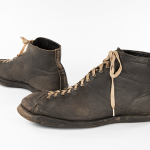
Museum’s are unusual places. Unlike most attractions offering education and entertainment like movie theatres and aquariums to the public, the Bata Shoe Museum not only offers four exhibitions for visitors to explore, but behind the scenes, it also keeps a collection of over 14,000 artefacts. The collection contains footwear that has been made, used and kept by individuals from around the globe and throughout time. It’s an encyclopedic collection — and all footwear or related items.
We have the collection so our curators can draw from it to illustrate the storylines featured in the exhibitions, and also to aid them in other footwear research. The collection is a gold mine of information in understanding the role of footwear in the social and cultural life of mankind. As our curators work on specific projects, they obtain new items that complement other things in our holdings, and these new items are added to the collection.

So, how do we keep track of all of this activity? Well, we keep track of all the items in the collection very carefully, and we track incoming items right from the moment the item starts its journey to the museum. Here is the first part of the process.
Transport to the museum happens in many different ways depending on the specific item: hand delivery, arranged pickup, mail, courier and fine art transport are all options. The items are of varying sizes, huge to tiny and in between. Once the mode of transport is selected and initiated, we begin tracking the package’s arrival to the museum.
As soon as the item arrives, the package is brought to the conservation lab were the package itself is examined for signs of harsh handling and potential damage to the item inside. The package is isolated in the lab and kept in its packaging for 48 hours, allowing the object inside to slowly adjust to the temperature and humidity of the museum. (During COVID-19, the isolation step has been adjusted to seven days for the safety of the staff). After the acclimation period, the package is opened. The item is inspected carefully for signs of damage and infestation.

After passing these precautionary measures, the item can be registered. Now cleared of harbouring infestation, it is brought into the main processing area, the Registration Room. Registering the item means that its arrival is recorded in a handwritten logbook as having been received at the museum, with basic identifying information including the date of arrival, sender, description and condition. The item is assigned a registration number. This registration number will be the item’s main identifier until it becomes a part of the collection permanently, when it will be given an additional identifying number.

The essential responsibility of the registration process is to record each collection item as it enters or leaves the museum, whether temporarily or permanently. This responsibility extends to the care of the item itself, especially in terms of its handling and storage, while it is being recorded and during unpacking, packing, transportation and its movement at all times.
As this first hand-written record will serve as a basis for the later processes of documentation and cataloguing, it is important that the entry in the registration logbook is accurate and clear. This is a permanent record. This initial record will be kept for generations and it will be a point of reference whenever research into the origins of the item’s acquisition is required.
The item’s disposition will also be entered in this logbook when that time comes, a bit later in the process. For now, the item is placed on a shelf in the Registration Room, awaiting the next step.
Suzanne Petersen, Collections Manager




